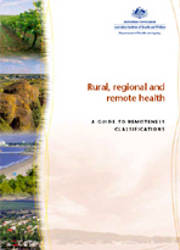Rural, regional and remote health: a guide to remoteness classifications
Citation
AIHW
Australian Institute of Health and Welfare (2004) Rural, regional and remote health: a guide to remoteness classifications, AIHW, Australian Government, accessed 18 April 2024.
APA
Australian Institute of Health and Welfare. (2004). Rural, regional and remote health: a guide to remoteness classifications. Canberra: AIHW.
MLA
Australian Institute of Health and Welfare. Rural, regional and remote health: a guide to remoteness classifications. AIHW, 2004.
Vancouver
Australian Institute of Health and Welfare. Rural, regional and remote health: a guide to remoteness classifications. Canberra: AIHW; 2004.
Harvard
Australian Institute of Health and Welfare 2004, Rural, regional and remote health: a guide to remoteness classifications, AIHW, Canberra.
PDF | 691Kb
The development over the last decade of geographical classifications for Australia that describe areas in terms of relative remoteness has provided an opportunity to compare a wide range of health and welfare indicators across Australia's major cities, regional and remote areas. This publication reviews the methodology behind the three major classifications that describe areas in this way - the RRMA (Rural, Remote and Metropolitan Areas) classification, the ARIA (Accessibility/Remoteness Index of Australia) classification and the ASGC (Australian Standard Geographical Classification) Remoteness Areas classification. This publication also summarises each classification's strengths and weaknesses and describes how the classifications are applied to administrative and survey data.
- ISSN: 1448 9775
- ISBN: 978 1 74024 369 8
- Cat. no: PHE 53
- Pages: 77



